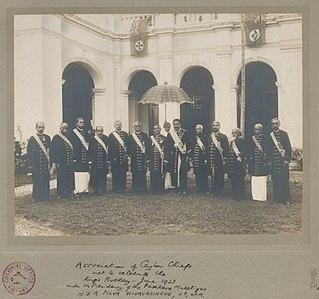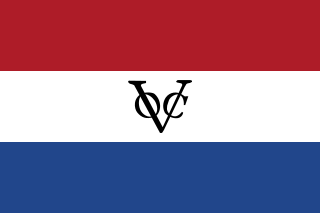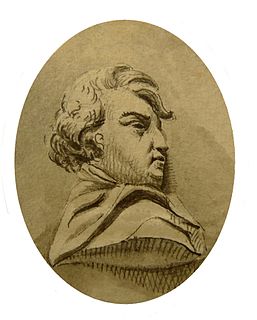Related Research Articles

Mudali was a colonial title and office in Ceylon which was part of the native headman system. The Portuguese colonials created the Mudaliyar class in the 17th century by enlisting natives of different castes from the coastal areas.

Dutch Ceylon was a governorate established in present-day Sri Lanka by the Dutch East India Company. Although the Dutch managed to capture most of the coastal areas in Sri Lanka,they were never able to control the Kandyan Kingdom located in the interior of the island. Dutch Ceylon existed from 1640 until 1796.

The American Ceylon Mission (ACM) to Jaffna,Sri Lanka started with the arrival in 1813 of missionaries sponsored by the American Board of Commissioners for Foreign Missions (ABCFM). Although they had originally planned to work in Galle,the British colonial office in Ceylon restricted the Americans to out-of-the-way Jaffna due to the security concerns of the British who were warring with France at the time. The critical period of the impact of the missionaries was from the 1820s to early 20th century. During this time,they engaged in original translations from English to Tamil,printing,and publishing,establishing primary,secondary and tertiary educational institutions and providing health care for residents of the Jaffna Peninsula. These activities resulted in many social changes amongst Sri Lankan Tamils that survive even today. They also led to the attainment of a lopsided literacy level among residents in the relatively small peninsula that is cited by scholars as one of the primary factors contributing to the recently ended civil war. Many notable educational and health institutions within the Jaffna Peninsula owe their origins to the missionary activists from America. Missionaries also courted controversy by publishing negative information about local religious practices and rituals.

Hendrick or Henricus Zwaardecroon was Governor-General of the Dutch East Indies from 1718 until 1725.

Joan Gideon Loten was a Dutch servant in the colonies of the Dutch East India Company,the 29th Governor of Zeylan,Fellow of the Royal Society and Fellow of the Society of Antiquaries of London. During his time in the colonies he made collections of natural history. In 1758 he moved to Holland. Nine months after his return from the Dutch East Indies he moved to London,where he lived for 22 years and interacted with scholarly societies and shared his natural history illustrations and collections. The sunbird species Cinnyris lotenius is named after him
Johannes Hertenberg was the 17th commander of Dutch Malabar from 1716 to 1723 and the 19th Dutch Governor of Ceylon from 1723 until his death.
Joan Paul Schaghen was an acting Governor of Ceylon in 1725 and 1726 and director-general of the council of the Dutch East India Company in Batavia from 1737 to 1741.

Petrus Vuyst or Vuijst was the 20th Governor of Ceylon during the Dutch colonial period.
Jan Macaré was an acting Dutch Governor of Ceylon during an interregnum from 7 June 1736 until 23 July 1736.
Gerard Joan Vreeland was the 28th Governor of Ceylon during the Dutch period in Ceylon. He was appointed on 6 May 1751 and was Governor until 26 February 1752. He was succeeded by acting Governor Jacob de Jong.
Anthony Mooyart was an acting Governor of Ceylon during the Dutch period in Ceylon. He was appointed on 13 May 1765 and was Governor until 7 August 1765. He was succeeded by Iman Willem Falck.

Willem Jacob van de Graaf was the 35th Dutch Governor of Ceylon during the Dutch period in Ceylon.

The Groote Kerk or Dutch Reformed Church is located within the Galle fort in Galle,Sri Lanka and is situated near the entrance to the fort. The church was built by the Dutch in 1755 and is one of the oldest Protestant churches still in use in the country.

Kruys Church or Kruys Kerk is located within the Jaffna fort in Jaffna,Sri Lanka and is situated near the entrance to the fort. The church was built by the Dutch in 1706 and was one of the oldest Protestant churches in the country.
Adriaen Adriaensz Roothaes was a Dutch captain,Commander of Galle,Ceylon,and acting Governor of Dutch Ceylon from November 1664 to April 1665.
Madapalli is a caste found mainly in the northern part of Sri Lanka. Found today as a subcaste of the Sri Lankan Vellalar,the Madapallis were considered an independent caste until recently.
Herbert Rayner Freeman was an English born Ceylonese public servant and politician.
Nooit Gedacht Heritage Hotel is a three-star heritage hotel in Unawatuna,Sri Lanka,at the base of Rumassala Kanda.

Louis Sansoni served as the second Postmaster General of Ceylon,between 1816 and 1825.
Lionel Frederick Lee,served as the Mayor of Colombo in 1887 and Treasurer of Ceylon in 1899.
References
- ↑ Cahoon, Ben. "Dutch Governors". Worldstatesmen. Retrieved 1 March 2013.
- ↑ S.A.W. Mottau, "Galle Two Centuries Ago", Memoir by Jacob de Jong, Commandeur of Galle, for his successor, 18 May 1748.